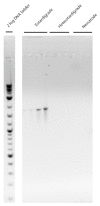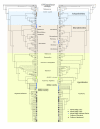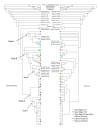Environmental DNA sequencing primers for eutardigrades and bdelloid rotifers
- PMID: 20003362
- PMCID: PMC2796995
- DOI: 10.1186/1472-6785-9-25
Environmental DNA sequencing primers for eutardigrades and bdelloid rotifers
Abstract
Background: The time it takes to isolate individuals from environmental samples and then extract DNA from each individual is one of the problems with generating molecular data from meiofauna such as eutardigrades and bdelloid rotifers. The lack of consistent morphological information and the extreme abundance of these classes makes morphological identification of rare, or even common cryptic taxa a large and unwieldy task. This limits the ability to perform large-scale surveys of the diversity of these organisms.Here we demonstrate a culture-independent molecular survey approach that enables the generation of large amounts of eutardigrade and bdelloid rotifer sequence data directly from soil. Our PCR primers, specific to the 18s small-subunit rRNA gene, were developed for both eutardigrades and bdelloid rotifers.
Results: The developed primers successfully amplified DNA of their target organism from various soil DNA extracts. This was confirmed by both the BLAST similarity searches and phylogenetic analyses. Tardigrades showed much better phylogenetic resolution than bdelloids. Both groups of organisms exhibited varying levels of endemism.
Conclusion: The development of clade-specific primers for characterizing eutardigrades and bdelloid rotifers from environmental samples should greatly increase our ability to characterize the composition of these taxa in environmental samples. Environmental sequencing as shown here differs from other molecular survey methods in that there is no need to pre-isolate the organisms of interest from soil in order to amplify their DNA. The DNA sequences obtained from methods that do not require culturing can be identified post-hoc and placed phylogenetically as additional closely related sequences are obtained from morphologically identified conspecifics. Our non-cultured environmental sequence based approach will be able to provide a rapid and large-scale screening of the presence, absence and diversity of Bdelloidea and Eutardigrada in a variety of soils.
Figures




Similar articles
-
Molecular evidence for Acanthocephala as a subtaxon of Rotifera.J Mol Evol. 1996 Sep;43(3):287-92. doi: 10.1007/BF02338837. J Mol Evol. 1996. PMID: 8703095
-
18S rRNA variability maps reveal three highly divergent, conserved motifs within Rotifera.BMC Ecol Evol. 2021 Jun 10;21(1):118. doi: 10.1186/s12862-021-01845-2. BMC Ecol Evol. 2021. PMID: 34112085 Free PMC article.
-
Phylogenomics of unusual histone H2A Variants in Bdelloid rotifers.PLoS Genet. 2009 Mar;5(3):e1000401. doi: 10.1371/journal.pgen.1000401. Epub 2009 Mar 6. PLoS Genet. 2009. PMID: 19266019 Free PMC article.
-
Back to the roots, desiccation and radiation resistances are ancestral characters in bdelloid rotifers.BMC Biol. 2023 Apr 7;21(1):72. doi: 10.1186/s12915-023-01554-w. BMC Biol. 2023. PMID: 37024917 Free PMC article. Review.
-
Recombination in bdelloid rotifer genomes: asexuality, transfer and stress.Trends Genet. 2024 May;40(5):422-436. doi: 10.1016/j.tig.2024.02.001. Epub 2024 Mar 8. Trends Genet. 2024. PMID: 38458877 Review.
Cited by
-
Soil rotifer communities are extremely diverse globally but spatially autocorrelated locally.Proc Natl Acad Sci U S A. 2011 Mar 15;108(11):4406-10. doi: 10.1073/pnas.1012678108. Epub 2011 Feb 22. Proc Natl Acad Sci U S A. 2011. PMID: 21368117 Free PMC article.
-
Iron Ladies - How Desiccated Asexual Rotifer Adineta vaga Deal With X-Rays and Heavy Ions?Front Microbiol. 2020 Jul 31;11:1792. doi: 10.3389/fmicb.2020.01792. eCollection 2020. Front Microbiol. 2020. PMID: 32849408 Free PMC article.
-
Freeze-thaw revival of rotifers and algae in a desiccated, high-elevation (5500 meters) microbial mat, high Andes, Perú.Extremophiles. 2017 May;21(3):573-580. doi: 10.1007/s00792-017-0926-2. Epub 2017 Mar 21. Extremophiles. 2017. PMID: 28321614
-
The widely used small subunit 18S rDNA molecule greatly underestimates true diversity in biodiversity surveys of the meiofauna.Proc Natl Acad Sci U S A. 2012 Oct 2;109(40):16208-12. doi: 10.1073/pnas.1209160109. Epub 2012 Sep 17. Proc Natl Acad Sci U S A. 2012. PMID: 22988084 Free PMC article.
-
Ionizing radiation responses appear incidental to desiccation responses in the bdelloid rotifer Adineta vaga.BMC Biol. 2024 Jan 25;22(1):11. doi: 10.1186/s12915-023-01807-8. BMC Biol. 2024. PMID: 38273318 Free PMC article.
References
-
- Stead TK, Schmid-Araya JM, Schmid PE, Hildrew AG. The distribution of body size in a stream community: one system, many patterns. J Anim Eco. 2005;74:475–487. doi: 10.1111/j.1365-2656.2005.00943.x. - DOI
-
- Fontaneto D, Herniou EA, Barraclough TG, Ricci C. On the global distribution of microscopic animals: new worldwide data on bdelloid rotifers. Zool Stud. 2007;46(3):336–346.
-
- Gomez A. Molecular Ecology of rotifers: from population differentiation to speciation. Hydrobiologia. 2005;546:83–99. doi: 10.1007/s10750-005-4104-7. - DOI
Publication types
MeSH terms
Substances
LinkOut - more resources
Full Text Sources
Molecular Biology Databases
Research Materials

